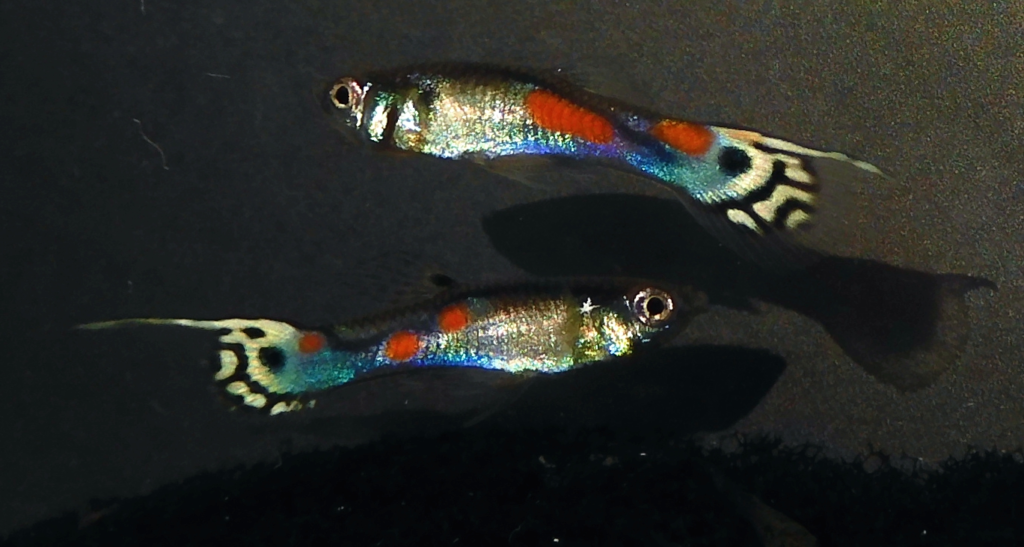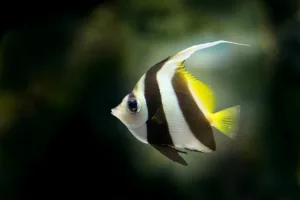The White Peacock Endler is characterized by its predominantly white or silver body coloration with varying amounts of iridescent and color accents, similar to the more common Endler’s Livebearers which come in a wide range of color variations. These freshwater fish are known for their vibrant and striking appearances, making them desirable choices for freshwater aquariums.
Endler’s Livebearers are relatively easy to care for, and they are known for their lively and active behavior, making them a popular choice among aquarists, especially those interested in breeding and maintaining colorful fish populations in their tanks. Like other livebearers, they give birth to live young, making them interesting to watch as they reproduce.
What is a white peacock Endler?
The White Peacock Endler is characterized by its predominantly white or silver body coloration with varying amounts of iridescent and color accents, similar to the more common Endler’s Livebearers which come in a wide range of color variations. These Tropical fish are known for their vibrant and striking appearances, making them desirable choices for freshwater aquariums.
Key characteristics of White Peacock Endler’s Livebearers guppies include:
- Size: White Peacock Endler’s are quite small, with males typically growing to around 0.8 to 1.2 inches (2 to 3 centimeters) in length, while females are slightly larger.
- Appearance: the primary coloration of White Peacock Endlers is white or silver. However, they may have iridescent accents and coloration in various areas, such as on their fins and along their sides. These iridescent colors can be blue, green, or other shades.
- Behavior: Endlers livebearer fish are generally peaceful fish and social, making them suitable for community aquariums. However, males can be territorial and may display some aggression towards one another.
- Habitat/Origin: White Peacock Endler’s Livebearers guppies are native to Venezuela, specifically in the Laguna de Patos and its surrounding waters. They prefer densely vegetated, slow-moving waters with plenty of hiding spots. Source – Wikipedia
- Reproduction: Like common guppies, White Peacock Endler’s Livebearers are livebearers, which means they give birth to live fry rather than laying eggs. They reproduce readily in the right conditions and can produce multiple batches of fry from a single mating.
- Care: White Peacock Endler Guppy fish are relatively easy to care for and can thrive in a well-maintained aquarium with suitable water conditions, such as warm water (around 75-82°F or 24-28°C) and slightly alkaline pH levels. They also benefit from a planted tank with plenty of hiding spots.
- Diet: endler livebearer are omnivorous and accept a wide range of foods. Their diet should include high-quality flake or pellet food, supplemented with live or frozen foods like brine shrimp, daphnia, and bloodworms.
- Lifespan: On average, Endlers guppies typically have a lifespan of 2 to 3 years in well-maintained aquariums.
- Tank Mates: neon tetras, cardinal tetras, or ember tetras, bronze corydoras or Panda Cory harlequin rasboras or chili rasboras cherry shrimp or amano shrimp, Green Moscow Guppy, Blue Hawaiian Moscow Guppy, Cobra Endler’s, Tiger Endler Guppy
The White Peacock Endler Guide – Tank Setup, Breeding, and Places To Buy
Tank Setup:
- Tank Size: A 10 to 20-gallon aquarium is suitable for a small group of White Peacock Endlers, but a larger tank can provide more stability and space for a community setup.
- Filtration: Use a gentle filtration system as Endlers don’t like strong water flow. A sponge filter or a low-flow hang-on-back filter is ideal.
- Heater: Maintain a stable temperature between 72-82°F (22-28°C) as White Peacock Endlers prefer slightly warmer water.
- Substrate: Fine-grained sand or gravel is suitable for the substrate. Live plants can be added for aesthetics and to provide hiding places for fry.
- Plants: White Peacock Endlers appreciate plants like Java Moss, Java Fern, and Hornwort. Floating plants can also help diffuse the light and create shaded areas.
Water Parameters:
- Temperature: Keep the water temperature around 74-78°F (23-26°C).
- pH Level: Aim for a slightly alkaline to neutral pH range between 7.0 and 8.0.
- Water Hardness: These fish can adapt to various water hardness levels but prefer moderately hard water with a hardness of 10-20 dGH.
Feeding:
- Diet: White Peacock Endlers are omnivores. Offer a varied diet that includes high-quality flake or pellet food specifically designed for small tropical fish. They will also benefit from live or frozen foods like daphnia, brine shrimp, and small insects.
- Feeding Frequency: Feed small amounts 2-3 times a day. Ensure they consume the food within a few minutes to prevent overfeeding, which can lead to water quality issues.
Breeding:

Breeding White Peacock Endler guppies is a relatively straightforward process, as they are livebearers. Here are the steps to successfully breed and care for White Peacock Endler guppy fry:
Breeding:
- Select Breeding Stock: Start by choosing healthy and mature White Peacock Endler males and females for breeding. Make sure the fish are in good condition and free from any diseases.
- Separate the Males and Females: If you plan to breed them intentionally, it’s a good idea to keep the males and females separate until you’re ready to initiate breeding. This separation can help control the breeding process.
- Provide a Breeding Tank: Set up a separate breeding tank, preferably a smaller one, around 5-10 gallons in size, with gentle filtration and a heater to maintain stable conditions. Ensure the tank is well-planted with live plants like Java Moss or Hornwort to provide hiding places for fry.
- Condition the Fish: Before introducing the males and females, feed them a varied diet of high-quality foods for a couple of weeks to ensure they are in optimal breeding condition.
- Introduce Males and Females: Place a few females and males in the breeding tank. The males will display colorful courting behavior and try to impress the females with their vibrant colors and displays. Ensure there are more females than males to reduce aggression.
- Breeding Process: The males will court the females and mate with them. White Peacock Endlers are livebearers, so the female will carry the fertilized eggs inside her body. Gestation usually lasts about three to four weeks.
Caring for Fry:
- Separate the Pregnant Female: When you notice a female is pregnant (her abdomen will appear swollen), you can move her to a separate tank to prevent the fry from being eaten by adult fish. Ensure the birthing tank has similar water conditions to the breeding tank.
- Live Birth: The female will give birth to live fry, and they are capable of swimming and feeding immediately. The number of fry can vary but may be as many as 20-30 in a single brood.
- Feed the Fry: Provide the fry with suitable food. Initially, you can feed them powdered fry food, liquid fry food, or newly hatched brine shrimp. As they grow, you can transition them to finely crushed flake food or small pellets.
- Maintain Water Quality: Ensure that the water quality in the fry tank is excellent. Perform regular water changes to keep the environment clean and healthy for the young fish.
- Growth and Development: White Peacock Endler fry grow quickly, and you will need to separate them or provide larger accommodations as they get bigger to prevent overcrowding.
- Selective Breeding: If you want to maintain specific color traits or patterns, selectively breed the fry from your preferred parents to improve the quality of your White Peacock Endler strain.
Troubleshooting:
- Diseases: White Peacock Endlers are susceptible to common aquarium diseases like fin rot and ich. Quarantine new fish and maintain good water quality to prevent these issues.
- Treatment: If you notice signs of illness, isolate the affected fish, and treat them with appropriate medications. Follow the instructions on the medication packaging and consult with a veterinarian or experienced aquarist if necessary.
Regular water changes, observation, and maintaining stable water parameters are key to keeping White Peacock Endlers healthy and thriving in your aquarium.
best places to buy and average price
The availability and prices of White Peacock Endler guppies can vary depending on your location, the specific strain or color variant you’re interested in, and the reputation of the seller. Here are some common places to purchase White Peacock Endler guppies and an estimate of the average price:
- Local Fish Stores (LFS): Many local fish stores carry various types of guppies, including White Peacock Endlers. Prices can range from $3 to $10 per fish, depending on their coloration and quality.
- Online Retailers: There are numerous online fish stores and breeders that specialize in selling guppies, including rare variants like White Peacock Endlers. Prices can vary widely, but you can often find them starting at around $5 per fish. Be aware that shipping costs may apply.
- Auctions and Classified Ads: You can also check out online aquarium forums and classified ads, where hobbyists often sell their guppies. Prices can vary, but you may find good deals, especially if you’re looking for specific strains or locally bred fish.
- Aquarium or Fish Club Meetings: Joining a local aquarium or fish club can be an excellent way to meet breeders and enthusiasts who may have White Peacock Endlers for sale or trade. Prices can vary, but you might get access to high-quality strains.
- Aquatic Conventions and Expos: Some aquatic conventions or expos feature hobbyist vendors and breeders selling various fish, including guppies. Prices can range widely, and you may find rare and unique strains at these events.
Keep in mind that the prices can fluctuate based on the rarity of the strain, the quality of the fish, and the reputation of the seller. It’s essential to buy from reputable sources that prioritize the health and quality of their fish, even if it means paying a bit more. Additionally, inquire about any specific care or breeding history of the fish when purchasing to ensure you’re getting healthy and well-maintained White Peacock Endlers.









